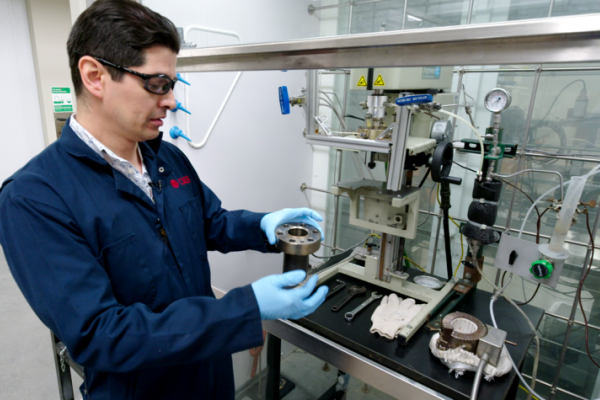Bourbon Stillage at CAER
In Kentucky, bourbon production is both a rich tradition and a booming industry. And as the state’s flagship research institution, the University of Kentucky has discovered an inventive way to work with a local bourbon distillery.
Steve Lipka, associate director at UK’s Center for Applied Energy Research (CAER), and his Electrochemical Power Sources team are always on the lookout for abundant and sustainable materials that can be converted into value-added products. In this case, Lipka and his team partnered with Wilderness Trail Distillery in Danville to test stillage, a by-product left over during the bourbon production process.
“It's of great value for us to look at industries here in Kentucky that can use those products in a very useful way and have a sustainable type of business,” said Lipka.
Bourbon stillage contains water and grain, and is often used as cattle feed in its solid state. But Lipka and his team have discovered multiple new uses for its liquid portion. Through a process called hydrothermal carbonization, the team learned that stillage can be transformed into a solid material made up of tiny, uniformly-sized particles, also known as green material.
“In Kentucky, we have this stillage that contains a lot of sugars and carbohydrates so we tried it and it works beautifully,” said Lipka. “We take these (green materials) and we then do additional post-processing to convert it into useful materials that can be used for batteries.”
These batteries include carbon-monofluoride batteries, the most energy-dense primary batteries in the world. Some applications for these types of batteries include:
- Implantable cardiac pacemakers
- Electronic devices: electric, water and gas meters, cameras, computer clock and memory back-up
- Commerce: powered credit cards
- Oil and gas exploration: data logging and control systems
- Automotive: tire pressure monitoring system
- U.S. military: portable communications equipment
- Aerospace
The materials may also be used for secondary batteries like lithium-ion, along with electrochemical capacitors, which are complementary storage devices to lithium batteries and ideal for capturing energy from alternative sources like solar or wind.
The stillage is also being used to create cheaper, more effective activated carbons for water filtration with funds from General Electric Appliances in Louisville. These systems could be useful for both consumer products and municipal drinking water supplies to remove chloramine and chloroform.
By using waste products like stillage, Lipka says this research could help bring down production costs and reduce reliance on other, more expensive sources of carbon.
“I think the most exciting thing for me, and for most people, is that you can take a product that is considered waste in many industries, and re-purpose it, or convert it into value-added product that has tremendous utility,” said Lipka. “I would like to get some of the distilleries interested in this and see this have some traction at the end of the day, and turn it into a business. I think it can be done. It would be another wonderful Kentucky story.”
More from this series Research Priorities - Energy
Credits
Produced by Alicia P. Gregory, videography/direction by Chad Rumford and Ben Corwin (Research Communications), text by Jenny Wells (UK Public Relations & Marketing)


